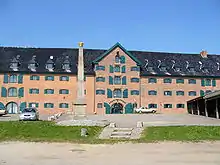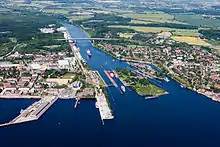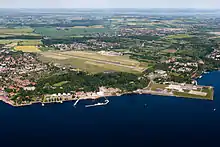Holtenau
Holtenau (Danish: Holtenå) is a district of Kiel, on the southeastern part of the Danish Wahld. It was historically part of the Duchy of Schleswig, and has cultural influences from both Germany and Denmark.
Holtenau
Holtenå | |
|---|---|
Urban district | |
 Holtenau Lighthouse | |
| Country | Germany |
| State | Schleswig-Holstein |
| City | Kiel |
| Incorporated | 1922 |
| Area | |
| • Total | 5.91 km2 (2.28 sq mi) |
| Population (2014) | |
| • Total | 5,204 |
| • Density | 880/km2 (2,300/sq mi) |
| Postal Code of Germany | 24159 |
| Area code(s) | 0431 |
The district is located at the mouth of the Kiel Canal on the Kieler Förde. Its location has made Holtenau a significant part of the region's shipping industry. Until 2012, a naval airbase was also operational in Holtenau.
History
Some ancient documents have referred to the region as Olthena or Altena. The district's current name may have derived from the Levensau river which flows into the Kiel Canal in Holtenau, though the exact etymology of the name is unclear.
The region was once a part of the Duchy of Schleswig. The village of Holtenau belonged to the Knoop estate and then later to the Seekamp estate. After the abolishment of serfdom in 1791, the village became part of the Eckernförde district. In 1922, the district was incorporated into Kiel. There were over 3,000 inhabitants at the time.
Kiel canal

The construction the Eider Canal began in 1777 near Holtenau and followed the Levensau river. The canal's Holtenau lock, which is no longer in use remains preserved as a heritage site. Near the lock, one the canal's three warehouses was constructed. Today it houses apartments and a restaurant.[1]

In 1895 Kiel Canal replaced the Eider Canal and brought an influx of traffic and business to the district.[2] The "canal steerers" (German: kanalsteurer), who direct traffic though the canal, are based in Holtenau.[3]
In 1895 the Holtenau lighthouse (German: Leuchtturm Holtenau) was erected at the entrance of the canal.[4] The lighthouse was commissioned by Kaiser Wilhelm II, who was also the original namesake of the Kiel Canal. Though the lighthouse serves a navigational purpose, it was also intended as a monument to glorify the German Empire.[5]
Kiel airport

In the 1880s, forts were constructed along the Kiel Förde. Fort Holtenau was completed in 1888 and housed approximately 250 men. The fort, along with all of the other Kiel forts, was demolished after the First World War. The area previously housing the fort was cleared and leveled in 1925 to allow for an expansion of the Kiel Airport.[6]
The airport opened in 1927 as a private organization. In 1934 the city sold the land to the state, expanded, and converted to a military airbase. To allow for the expansion of the airbase and the construction of military facilities, many locals were forced to sell their properties. At the onset of the Second World War a quarter of all people living in Holtenau worked at the airbase as members of the Luftwaffe.[7]
The airport fell into decline after the war. In 1958, after the establishment of the German Navy, the Marineflieger reconstructed the base and created the naval pilot division of Marinefliegergeschwader 5 (MFG 5) at the new site. MFG 5 has since moved their division to Nordholz Naval Airbase.[8][9]
All military operations at the airbase ceased in 2012. At its closure the base covered 92 hectares of land, the majority of which is now being converted for public use.[10]
Culture
Religion
Holtenau was part of the Dänischenhagen parish until 1895. Today, the Danish Church in Southern Schleswig has a congregation in the community.
In 1897, the Dankeskirche was founded as an independent evangelical lutheran church. The church's name, which means Thank You Church, was meant to express gratitude for the construction of the Kiel Canal. The church's tower was originally 52 meters tall, but was shortened to 26 meters when the airbase was built.[11]
Holtenau is also part of the Roman Catholic parish of Kiel-Nord, which was founded at the same time the district was incorporated into Kiel in 1922. The parish's St. Elisabeth Church was built in 1958. Due to a decline in attendance, the church was dissolved by the diocese of Hamburg in 2003. Its facilities were converted into an architect's office in 2006.[12]
Education
The district has had a primary school since at least 1741, thought the current school was built in 1961.[13] The closest secondary school, Altenholz Gymnasium, is located in the neighboring town of Altenholz.
External links
![]() Media related to Holtenau at Wikimedia Commons
Media related to Holtenau at Wikimedia Commons
References
- Watty, Fred (2012). Kiel and the Fjord Region. Sutton Verlag GmbH. pp. 41–45. ISBN 9783954000616.
- Pieper-Wöhlk, Hannelore; Wöhlk, Dieter (2009). Der Nord-Ostsee-Kanal: Geschichte eines Jahrhundertbauwerks (in German). Sutton Verlag GmbH. ISBN 9783866804685.
- "Kanalsteurer trainieren Extremsituationen im Simulator der FH". www.pressebox.de (in German). 2013-09-30. Retrieved 2020-06-18.
- Hans-Jürgen, Fründt (2018). Reise Know-How Reiseführer Schleswig-Holstein (in German). Reise Know-How Verlag Peter Rump. p. 8. ISBN 9783831745746.
- "Leuchtturm Holtenau". holtenau-info.de (in German). Archived from the original on 2012-07-13.
- Morio, Bert (2017-09-25). "Geschichte Holtenaus - Das Fort Holtenau". www.apt-holtenau.de (in German). Retrieved 2020-06-18.
- Morio, Bert (2019-09-30). "Geschichte Holtenaus - Der Holtenauer Flugplatz". www.apt-holtenau.de (in German). Retrieved 2020-06-18.
- Morio, Bert (2017-11-08). "Geschichte Holtenaus - Das Marinefliegergeschwader 5". www.apt-holtenau.de (in German). Retrieved 2020-06-18.
- Rosenthal, Jürgen K.G. "Das Marinefliegergeschwader 5". www.hardthoehenkurier.de (in German). K&K Medienverlag-Hardthöhe GmbH. Retrieved 2020-06-18.
- "Kieler Sanierungsgebiet Holtenau Ost | Entwicklung des MFG 5-Geländes". www.kiel.de (in German). Retrieved 2020-06-18.
- Morio, Bert (2019-08-25). "Geschichte Holtenaus - Die Holtenauer Kirchengemeinde". www.apt-holtenau.de (in German). Retrieved 2020-06-18.
- Morio, Ben (2018-11-05). "Geschichte Holtenaus - Die Sankt Elisabeth Kirche". www.apt-holtenau.de (in German). Retrieved 2020-06-18.
- "Schulchronik - Schule Holtenau". Schule Holtenau (in German). Archived from the original on 2014-08-09.
